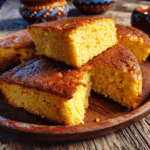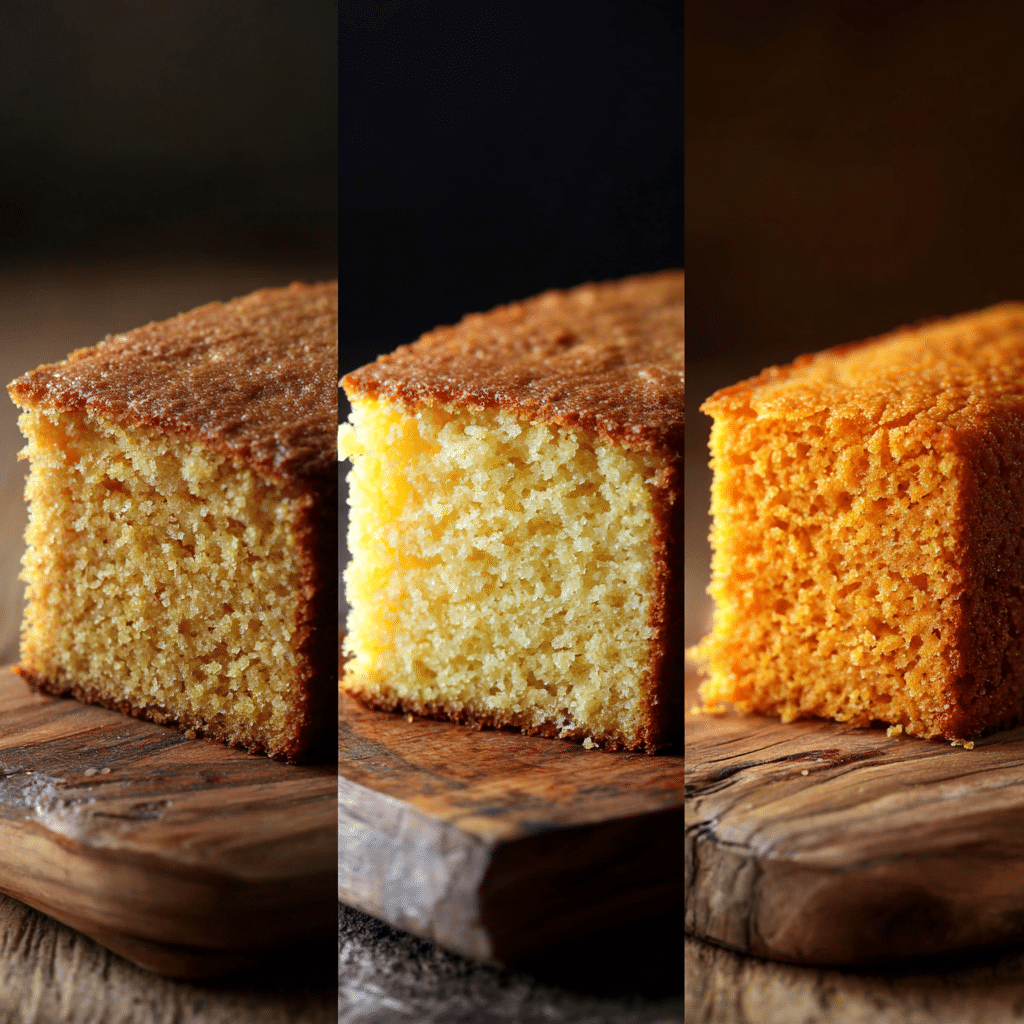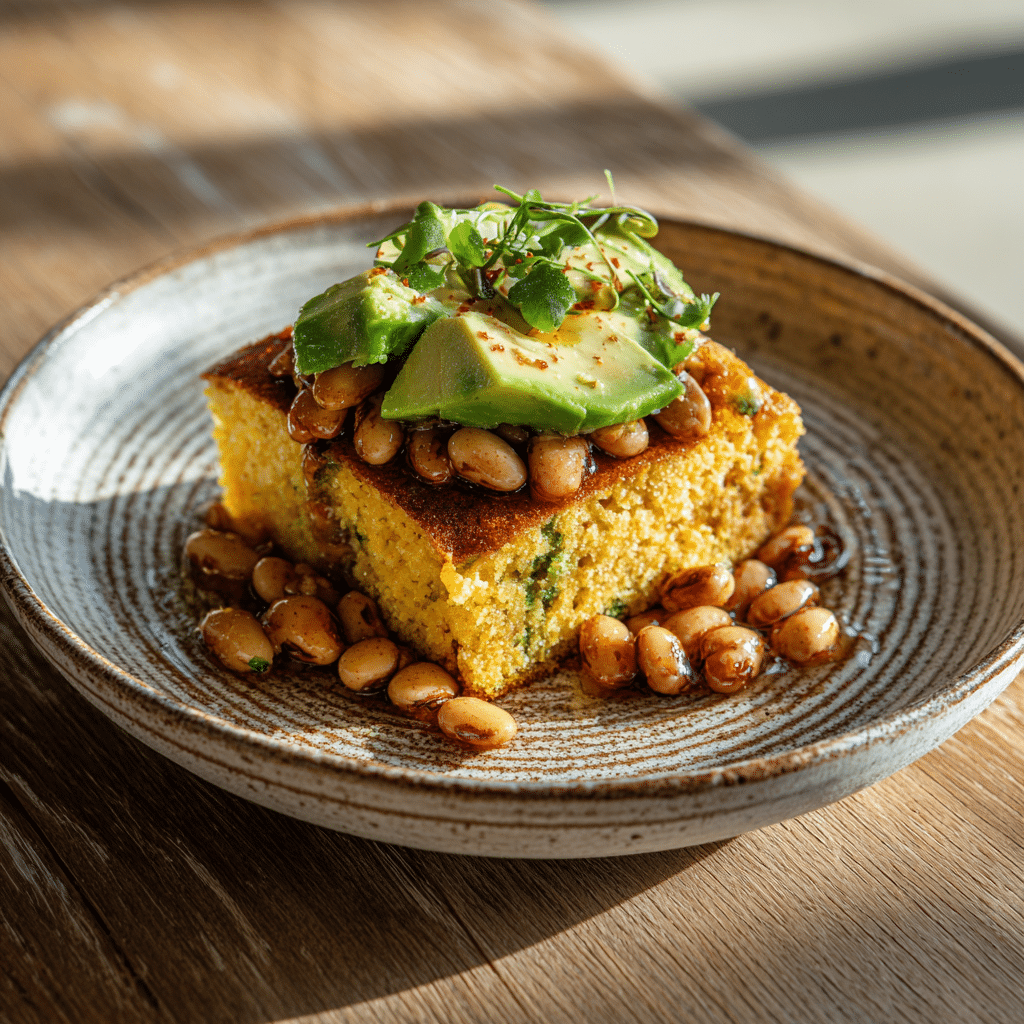Cornbread is beloved in kitchens across America, but most people haven’t tasted it in its oldest, most traditional form—Navajo cornbread. Made with blue cornmeal and rooted in indigenous foodways, this rustic bread isn’t just another variation—it’s a direct link to centuries of Native American culture, survival, and nutrition.
In this article, you’ll discover what sets Navajo cornbread apart from the typical Southern or Mexican styles. We’ll explore its deep cultural origins, the ingredients that give it integrity and character, and how it continues to thrive in modern kitchens. Whether you’re curious about its history or ready to make it from scratch, this guide will walk you through everything—including common questions like What did Native Americans call cornbread? and How do you get the texture just right without added sugar or flour?
Check out this sugar-free lemon blueberry pudding cake for a naturally sweet pairing to complement your next cornbread bake.


- Total Time: 40 minutes
- Yield: 6–8 slices 1x
Description
A dense, rustic, and naturally gluten-free bread made with stone-ground blue cornmeal. This traditional Navajo cornbread recipe is nutrient-dense, dairy-optional, and perfect for pairing with stews, beans, or roasted vegetables.
Ingredients
2 cups stone-ground blue cornmeal
1½ cups water or buttermilk (unsweetened)
1 tsp sea salt
½ tsp baking soda
2 tbsp lard or neutral oil (avocado, vegetable, or sunflower)
(Optional) ½ tsp juniper ash or food-grade ash substitute
Instructions
1. Preheat oven to 375°F (190°C). Place a cast iron skillet or baking dish inside with 1 tbsp oil to heat.
2. In a medium bowl, mix blue cornmeal, salt, and baking soda.
3. Slowly pour in water or buttermilk. Stir gently just until combined. Avoid overmixing.
4. Let the batter rest at room temperature for 10–15 minutes.
5. Carefully remove the hot pan from the oven. Add the remaining oil and swirl to coat.
6. Pour the rested batter into the hot skillet, smoothing the top.
7. Bake for 25–30 minutes or until golden and firm in the center.
8. Let cool slightly before slicing and serving.
Notes
Blue cornmeal gives this bread its unique flavor, color, and nutritional boost. Yellow cornmeal can be used, but it won’t be traditional.
For a modern twist, you may add 1–2 tbsp roasted green chiles, herbs, or sunflower seeds—though classic Navajo recipes remain plain.
Best served with beans, stews, or topped with avocado or clarified butter.
- Prep Time: 10 minutes
- Cook Time: 30 minutes
- Category: Bread
- Method: Baked
- Cuisine: Native American / Southwestern
Nutrition
- Serving Size: 1 slice
- Calories: 130
- Sugar: 0g
- Sodium: 230mg
- Fat: 6g
- Saturated Fat: 1g
- Unsaturated Fat: 4g
- Trans Fat: 0g
- Carbohydrates: 18g
- Fiber: 2g
- Protein: 3g
- Cholesterol: 0mg
Native American Cuisine and Corn’s Central Role
To the Navajo and other Indigenous peoples of North America, corn has always been more than just a staple crop—it’s a symbol of life, balance, and community. Corn was grown with care and gratitude, used in both daily meals and sacred ceremonies. Among its varieties, blue corn holds special significance. Revered for its deep nutritional value and resilience in harsh climates, blue corn was often ground into meal and used to prepare hearty breads that nourished generations.
Before ovens and electric mixers, Navajo cornbread was cooked on hot stones or in clay ovens. The process was slow and intentional. Breads were made dense, not fluffy—meant to sustain, not simply please the palate. This form of cornbread stood at the center of home, tradition, and ceremony.
What sets Navajo cornbread apart is its commitment to simplicity. The ingredients are few, but each one plays a vital role. The bread is made with care—not shortcuts—and reflects a philosophy of cooking that values wholesomeness over excess.
- Blue Cornmeal: Ground from heritage blue corn, it’s richer in flavor, higher in protein, and darker in color than yellow or white cornmeal.
- Water or Buttermilk: Used to moisten and bind the ingredients without softening the naturally firm structure. Buttermilk is a modern substitute for a slight tang.
- Salt & Baking Soda: Just enough to activate the batter and bring balance without turning the bread into a fluffy loaf.
- Lard or Oil: Traditionally made with animal fat from game, though many today use neutral plant-based oils to keep the bread moist and flavorful.
- Juniper Ash (Optional): Burned juniper branches are used in traditional preparation to increase calcium content and subtly lighten the texture and color.
Because it contains no refined flour, no sugar, and no artificial additives, Navajo cornbread fits cleanly into gluten-free and whole-food diets without needing adjustments. It’s a recipe rooted in function—dense, satisfying, and deeply connected to the land and its people.
Looking for contrast in flavor and texture? Pair this with a soft, cloud-light cake for a naturally balanced meal experience.
At first glance, all cornbread might look similar—but dig a little deeper, and you’ll see how uniquely different Navajo cornbread really is. While most American versions of cornbread have evolved to fit modern preferences—often becoming sweeter, fluffier, and lighter—Navajo cornbread stays grounded in tradition.

Here’s a side-by-side comparison to break it down clearly:
| Feature | Southern Cornbread | Northern Cornbread | Navajo Cornbread |
|---|---|---|---|
| Sweetness | Usually savory | Often slightly sweet | Never sweetened |
| Texture | Moist, cake-like | Light, fluffy | Dense and hearty |
| Key Grain | Yellow cornmeal | Yellow/white cornmeal | Stone-ground blue cornmeal |
| Leavening | Baking powder, eggs | Baking soda/powder | Minimal leavening |
| Preparation | Oven-baked | Oven-baked | Clay oven or cast iron |
| Cultural Roots | Southern U.S. cooking | New England traditions | Indigenous Navajo cuisine |
Unlike its fluffier cousins, Navajo cornbread is dense by design. It’s not trying to be dessert. It’s meant to fuel and nourish—especially in communities that lived close to the land and needed energy-dense food to get through tough climates.
You also won’t find sugar or white flour in a traditional recipe. It’s gluten-free by default and made to emphasize whole grain nutrition, not refined softness.
Don’t miss our keto-friendly bread alternative if you’re exploring more low-carb or heritage-inspired options with health in mind.
The Unique Use of Blue Cornmeal & Stone Ground Corn
One of the most defining features of Navajo cornbread is the use of blue cornmeal. This isn’t just for visual appeal—it dramatically changes the nutritional profile and taste.
- Blue corn contains more protein and antioxidants than yellow or white corn.
- It has a subtly nutty, toasted flavor that’s rich without being overpowering.
- Because it’s often stone-ground, the resulting cornmeal is coarser, which adds texture and bite to the finished bread.
Blue corn also holds ceremonial value in Navajo culture. It symbolizes endurance, wisdom, and a spiritual connection to the Earth. By using it, this bread becomes more than just a meal—it reflects ancestral knowledge and pride.
Modern recipes might substitute it with yellow cornmeal when blue isn’t available, but the flavor, appearance, and cultural weight aren’t quite the same.
Looking for something to serve alongside? Try this Bahama Mama smoothie to contrast the deep tones of blue corn with something light and tropical.
Core Ingredients and Smart Substitutes
At its heart, Navajo cornbread is built on resourcefulness. Traditional recipes used what was available in the region—no fluff, no filler. If you want to make it the classic way, you only need a few ingredients. However, if you’re working with what’s in your pantry, there are a few clever substitutes that still honor the essence of the original.

Here’s a basic ingredient list and possible swaps:
| Traditional Ingredient | Purpose | Modern Substitution |
|---|---|---|
| Blue cornmeal | Base grain, adds flavor | Yellow cornmeal (if needed) |
| Water | Moisture | Buttermilk or nut milk |
| Baking soda | Light rise | Baking powder (in small qty) |
| Salt | Flavor enhancer | Sea salt or pink salt |
| Lard | Fat for binding & texture | Avocado oil, coconut oil |
| Juniper ash (optional) | Adds calcium, tradition | Omit or use baking ash mix |
While modern substitutions can offer convenience, using blue cornmeal and traditional fat sources will get you as close as possible to authentic taste and texture. The bread will have a thicker crumb, a mild nuttiness, and a natural earth-tone flavor.
Looking for indulgence without guilt? Explore our high-protein brownies for a wholesome dessert pairing that won’t undo your healthy efforts.
Cooking Methods: Oven, Cast Iron, and Open Fire
One of the most unique aspects of Navajo cornbread is how it’s cooked. Traditionally, the bread was baked in clay ovens or on hot stones, methods that infused a smokiness and depth of flavor rarely achieved in modern ovens. But even today, you can replicate the experience in your home kitchen.
Here are three methods to choose from:
1. Cast Iron Skillet (Most Authentic Option)
- Preheat the skillet in your oven with a bit of oil or lard to develop a crisp outer crust.
- Pour in the thick batter and bake at 375°F for 25–30 minutes.
- Finish under the broiler for a golden top.
2. Clay or Dutch Oven (Traditional Style)
- Line the pot with natural leaves (like corn husk or parchment).
- Bake low and slow to develop earthy tones and steam-lock moisture.
3. Oven-Baked Sheet Method (Quick and Easy)
- Use a greased 9×9 baking dish.
- Bake at 375°F for 30 minutes or until golden and firm in the center.
Navajo cornbread isn’t meant to be fluffy. Expect it to feel solid and satisfying—ideal for scooping up stew, pairing with beans, or standing alone with a drizzle of honey (if you’re bending the tradition just a bit).
Looking for something cooling and citrusy to serve after? Try our Bahama Mama smoothie recipe for a sweet finale.
The Evolution of Cornbread Across Cultures
At first bite, Mexican cornbread and Navajo cornbread might seem similar—they’re both made from cornmeal, often served warm, and connected to native traditions. But a deeper look reveals that they reflect very different cultural paths.
Mexican cornbread, often referred to as pan de elote, is:
- Slightly sweet
- Sometimes includes creamed corn, cheese, or jalapeños
- Fluffy and moist, baked with baking powder and eggs
- Served more as a side dish or snack than a ceremonial bread
Meanwhile, Navajo cornbread:
- Contains no sugar or dairy by default
- Uses blue cornmeal instead of yellow or white
- Offers a coarse, grounded texture
- Carries deep cultural and spiritual meaning, often tied to ritual and survival
These differences stem from the food adaptations that occurred post-colonization. As European ingredients like wheat, sugar, and dairy spread, Native recipes shifted—but Navajo cooks preserved many of the original preparation methods.
Want a health-conscious bread that blends modern taste with tradition? Explore our keto bread recipe here for a grain-free option inspired by the past.
Influence of Colonialism on Cornbread Styles
Colonialism transformed food across the Americas—including how cornbread was made and eaten. European settlers introduced ingredients like refined flour, baking powder, and sugar. Over time, these additions shifted cornbread from a dense survival food to a sweeter, cake-like staple, especially in the Southern U.S.
But not every community embraced the change.
The Navajo people maintained their original approach—keeping the bread minimal, nutrient-dense, and focused on natural ingredients. Even today, traditional Navajo cornbread doesn’t rely on sweeteners or softeners. Instead, it remains rugged, honest, and full of meaning.
This contrast reflects more than just flavor preference—it shows how food traditions are protected, adapted, or erased under external pressure. Navajo cornbread survives as both a recipe and a form of cultural preservation.
Looking for a soft, comforting finish to this hearty bread? Don’t miss our cloud cake recipe for something light and modern.
How to Get the Texture, Moisture, and Flavor Just Right
While Navajo cornbread may appear simple, there are key steps that make the difference between dry and delicious. This isn’t a quick mix-and-bake recipe—it’s a mindful process where every step adds something to the final result. Here’s how to make sure your batch turns out just the way it should.
- Start with quality blue cornmeal
Using fresh, stone-ground blue cornmeal gives your bread better structure and depth of flavor. If your cornmeal is stale or too finely milled, it can leave the texture flat or grainy. - Preheat your pan before pouring in the batter
Whether you’re using a cast iron skillet or a baking dish, warming it up with a little oil helps create a crisp edge and prevents sticking. It also locks in flavor right from the start. - Go easy on the mixing
Mix just enough to combine your ingredients. Overworking the batter can lead to dense or uneven results and takes away from the natural, hearty crumb Navajo cornbread is known for. - Allow the batter to rest
After mixing, let your batter sit uncovered for 10 to 15 minutes. This helps the cornmeal absorb the liquid evenly, leading to a smoother texture throughout the bread when baked. - Bake at a steady, moderate temperature
Set your oven between 350°F and 375°F. Baking low and steady gives the bread time to firm up on the inside without overbaking the crust. It also helps keep moisture locked in, giving the bread that satisfying bite without dryness. - Be selective with add-ins
If you want to explore flavors beyond tradition, keep it subtle. A small amount of chopped green chile, roasted seeds, or native herbs can enhance the bread without masking the natural taste of blue corn. The original recipe was designed to be humble, clean, and focused.
Common Mistakes That Ruin Texture or Flavor
Even traditional recipes can go off track if you’re not careful. Here are the top mistakes that often lead to disappointing results—and how to avoid them:
| Mistake | What Goes Wrong | How to Fix It |
|---|---|---|
| Using yellow or white cornmeal | Dulls the flavor and loses cultural context | Always choose blue cornmeal for authenticity |
| Adding sugar or all-purpose flour | Softens texture and alters traditional profile | Keep the ingredients simple and unrefined |
| Skipping pan preheating | Results in uneven cooking or a soggy base | Heat your baking surface with oil before pouring |
| Cranking up the oven temperature | Overbakes the crust and dries out the inside | Stick to 350–375°F for a balanced bake |
| Stirring the batter too much | Makes the bread heavy and gummy | Mix gently—just enough to combine |
Think of Navajo cornbread not just as a recipe, but as a rhythm. The pace, the temperature, the patience—it all works together to produce a bread that’s deeply satisfying and connected to its origins.
Looking for something nourishing and sweet to follow your meal? Check out our protein brownies—packed with flavor and perfect for a balanced finish.
Navajo cornbread was never meant to be eaten in isolation. Traditionally, it was served alongside rich stews, roasted meats, or hearty legumes. Its dense texture and earthy flavor make it the perfect base for scooping, dipping, or crumbling into a bowl of soup.
Here are some traditional-style pairings to try:
- Mutton stew or chili: The dense structure of the cornbread makes it ideal for sopping up flavorful broth and juices.
- Pinto beans with green chile: A Southwest favorite—just add a warm slice of cornbread on the side for a satisfying, balanced meal.
- Native corn stew: Corn on corn may sound repetitive, but the contrast between soft stew and firm bread creates a layered, comforting bite.
Want to level up a simple meal? Add a slice of warmed Navajo cornbread topped with clarified butter and a pinch of salt—minimal but rich.
While the roots of Navajo cornbread are firmly planted in tradition, that doesn’t mean you can’t adapt how it’s served. This bread is versatile and works surprisingly well in fusion meals or updated health-conscious recipes.

Try it these ways:
- As a cornbread base for tostadas or open-faced tacos
Slice the bread into rounds or wedges, toast lightly, and top with beans, avocado, salsa, or pulled chicken. It’s a gluten-free twist on traditional taco shells. - Crumbled over roasted vegetables or grain bowls
Add texture to modern dishes by crumbling cooled pieces of cornbread over salads, bowls, or warm veggie mixes. - As a savory breakfast base
Top a slice with eggs, kale, or sautéed onions. The firm crumb holds up well under runny yolks or avocado. - Sweet-style with honey or fruit compote (optional)
While not traditional, drizzling a small amount of local honey or berry jam can create a satisfying snack or light dessert—especially when the bread is still warm.
Looking for a bright, fruity dessert pairing? Try our blueberry coffee cake for a sweet follow-up that balances the hearty feel of traditional cornbread.
Nutritional Benefits of Traditional Cornmeal
Blue Cornmeal vs. Yellow Cornmeal: A Nutritional Comparison
Not all cornmeal is created equal—and when it comes to making Navajo cornbread, using the right kind makes a big difference in both flavor and health benefits. While yellow cornmeal is the most common variety in U.S. supermarkets, blue cornmeal is the traditional choice for Navajo recipes—and it packs a more powerful nutritional punch.
Here’s how they compare:
| Nutrient | Blue Cornmeal (per 100g) | Yellow Cornmeal (per 100g) |
|---|---|---|
| Protein | Higher (~8–9g) | Moderate (~6–7g) |
| Fiber | Higher | Lower |
| Antioxidants | Rich in anthocyanins | Low |
| Glycemic Index | Lower | Higher |
| Flavor | Earthy, nutty | Mild, slightly sweet |
Blue cornmeal is especially rich in anthocyanins—the same antioxidant compounds found in blueberries—which have been linked to heart health and reduced inflammation. That makes it not just flavorful, but functional.
Gluten-Free, High-Fiber, and Clean-Eating Friendly
One of the biggest advantages of Navajo cornbread is what’s not in it. Because the recipe is traditionally made without wheat, refined sugars, or preservatives, it fits beautifully into modern whole-food diets. It’s naturally:
- Gluten-free: Made without flour or wheat-based ingredients
- High in fiber: Especially if you use stone-ground or coarse cornmeal
- Free from added sugar: Making it low-glycemic and ideal for balanced eating
- Full of complex carbs: A steady energy source, especially when paired with protein or legumes
That’s why this heritage bread is not just a cultural food—it’s a smart nutritional choice. It delivers on flavor, satisfies hunger, and supports gut health, blood sugar balance, and digestion without needing anything artificial.
Don’t miss our keto bread recipe for another nourishing, low-glycemic alternative that fits gluten-free lifestyles.
How Chefs and Home Cooks Are Reviving the Dish
While Navajo cornbread has ancient roots, it’s seeing a well-deserved revival in both professional kitchens and home cooking circles. As more people seek out heritage recipes and nutrient-dense foods, this traditional bread has found its place on modern plates—not just for its cultural richness, but also for its flavor and versatility.
Chefs are reintroducing it on menus with twists that still respect its origins:
- Paired with modern stews, vegan chili, or roasted vegetables
- Often served as an appetizer alongside herb butter or aromatic infused oils.
- Incorporated into Southwest-inspired dishes or deconstructed native plates
Meanwhile, home cooks are drawn to its simplicity—just a handful of ingredients, one bowl, no mixer, and minimal fuss. It’s become a go-to recipe for those seeking to cook with purpose and reduce processed foods.
Social media has also helped fuel the comeback. Food bloggers and cultural influencers are sharing Navajo cornbread not as a trend, but as a story—something that connects us back to the land, the people, and the principles of sustainable eating.
With the rise of clean-eating lifestyles, Navajo cornbread fits surprisingly well into contemporary nutrition philosophies:
- Gluten-Free: No wheat or refined flour makes it naturally suitable for gluten-sensitive diets
- Whole-Food Based: Contains only unprocessed ingredients
- Plant-Based Friendly: Easily made vegan with oil and non-dairy liquid
- Low-Sugar: Ideal for those watching their glycemic load
- Rich in fiber: making it excellent for digestion and overall gut health.
Whether you’re following a whole 30, paleo-inspired, or simply clean lifestyle, this is one bread you don’t have to modify heavily. It already aligns with today’s health goals—because it was built around nourishment, not indulgence.
Looking for more clean dessert ideas? Check out our sugar-free lemon blueberry pudding cake for a fresh and satisfying finish to your meal.
Navajo cornbread is more than just a rustic side dish—it’s a living link to heritage, simplicity, and wholesome eating. Rooted in Indigenous tradition and powered by nutrient-rich blue cornmeal, this recipe stands in stark contrast to modern, sugar-filled breads. It’s naturally gluten-free, deeply satisfying, and intentionally made to nourish both body and soul.
Whether you’re making it as a tribute to cultural recipes or seeking clean, grounded alternatives to commercial bread, Navajo cornbread offers something rare: flavor with purpose. Every bite connects you to generations of wisdom and a cooking tradition that values ingredients as much as meaning.
So the next time you want to try something new—but deeply rooted in something old—skip the mix and start with blue cornmeal. Navajo cornbread might become your new favorite recipe you didn’t know you were missing.
Looking for more clean-eating recipes? Check out this guilt-free cloud cake to round out your meal with something light and nourishing.
Love this recipe? There’s more where that came from! Visit our Pinterest for visual inspiration and Medium for in-depth guides.
What did Native Americans call cornbread?
Cornbread wasn’t known by just one name across all tribes—it varied depending on region and language. Among Southwestern tribes like the Navajo, cornbread was often referred to using native terms for cornmeal-based bread or cake. For the Navajo specifically, food made from blue cornmeal might be called dah díníilghaazh, referring to traditional blue corn cakes or steamed bread. These breads were part of daily life and spiritual rituals, not just meals.
What’s the difference between Mexican cornbread and regular cornbread?
Mexican cornbread is typically moist, sweet, and often loaded with extras like cheese, green chiles, or corn kernels. It’s closer to a savory cake than a traditional bread. Regular (American-style) cornbread varies by region—Southern versions are savory and skillet-baked, while Northern types are usually sweeter and fluffier. In contrast, Navajo cornbread is dense, earthy, and made without sugar or cheese. It sticks to ancestral methods and relies on blue cornmeal for its distinctive taste and texture.
What is the secret to making good cornbread?
The secret lies in quality ingredients and simple technique. For Navajo cornbread, using fresh, stone-ground blue cornmeal is key. Preheating your skillet, avoiding overmixing, and letting the batter rest before baking all help create a firm yet moist interior and a crisp, flavorful crust. Unlike modern cornbread, which might use sugar or flour for fluffiness, this version celebrates cornmeal in its purest form.
What is the difference between northern and southern style cornbread?
Northern cornbread is usually sweet, soft, and cake-like. It often includes sugar, baking powder, and milk, giving it a light, spongy feel. Southern cornbread is denser, typically baked in a cast iron skillet, and served with savory dishes like collard greens or BBQ. Both rely on yellow or white cornmeal. Navajo cornbread, however, is distinct from both—made with blue cornmeal, it’s naturally gluten-free, unsweetened, and deeply tied to Native American culinary traditions.

